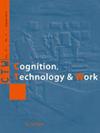Sickness absence from work in the footwear industry: A longitudinal study.
IF 3.4
3区 工程技术
Q2 ENGINEERING, INDUSTRIAL
引用次数: 1
Abstract
BACKGROUND Studies on illness in the footwear industry have prioritized specific work sectors and diseases. OBJECTIVES To analyze the main factors related to sickness absence and the indicators of illness in terms of recurrence and workdays lost among workers at a footwear company, ranging from storage of raw material to distribution of the final product. METHODS A total of 9072 cases of absence from work were investigated in shoe production units from 2014 to 2017. Univariate models estimated the risk of bodily dysfunction (physiological and psychological) and the severity of recurrence and work days lost. RESULTS (1) Most production units and work sectors were related to one or more affected bodily functions; (2) Neuromusculoskeletal and movement-related functions and the work sectors of prefabrication; cutting, assembly and finishing; and quality inspection of the final product required a longer recovery time before return to work and had a greater recurrence of leave; and (3) Women seemed to be more affected than men in terms of the reappearance of symptoms. CONCLUSIONS Illness differs according to occupational sectors. The production sectors present more serious situations due to physical overload, intense rhythm and concentration, monotony and low autonomy.制鞋业的病假:一项纵向研究。
关于鞋类行业疾病的研究优先考虑了特定的工作部门和疾病。目的分析某鞋业公司员工从原材料储存到最终产品配送过程中病假缺勤的主要影响因素、疾病复发指标和病假缺勤天数。方法对2014 - 2017年鞋类生产单位9072例缺勤情况进行调查。单变量模型估计了身体功能障碍的风险(生理和心理)、复发的严重程度和工作日损失。结果(1)大多数生产单位和工作部门与一种或多种受影响的身体功能有关;(2)神经肌肉骨骼和运动相关功能及预制件工作部门;切割、装配、精加工;最终产品的质量检验需要较长的恢复时间才能返回工作岗位,并且请假的复发率较大;(3)在症状重现方面,女性似乎比男性更容易受到影响。结论不同职业的发病情况不同。生产部门由于体力负荷过重、节奏和集中程度高、单调和自主性低,情况更为严重。
本文章由计算机程序翻译,如有差异,请以英文原文为准。
求助全文
约1分钟内获得全文
求助全文
来源期刊

Cognition Technology & Work
ENGINEERING, INDUSTRIAL-
CiteScore
6.90
自引率
7.70%
发文量
26
审稿时长
>12 weeks
期刊介绍:
Cognition, Technology & Work focuses on the practical issues of human interaction with technology within the context of work and, in particular, how human cognition affects, and is affected by, work and working conditions.
The aim is to publish research that normally resides on the borderline between people, technology, and organisations. Including how people use information technology, how experience and expertise develop through work, and how incidents and accidents are due to the interaction between individual, technical and organisational factors.
The target is thus the study of people at work from a cognitive systems engineering and socio-technical systems perspective.
The most relevant working contexts of interest to CTW are those where the impact of modern technologies on people at work is particularly important for the users involved as well as for the effects on the environment and plants. Modern society has come to depend on the safe and efficient functioning of a multitude of technological systems as diverse as industrial production, transportation, communication, supply of energy, information and materials, health and finance.
 求助内容:
求助内容: 应助结果提醒方式:
应助结果提醒方式:


